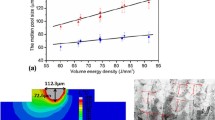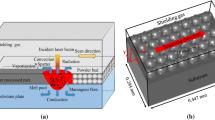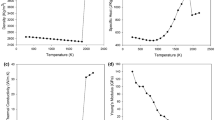Abstract
The unique thermal cycle of selective laser melting (SLM) significantly affects the undesirable formability and mechanical properties of the deposited parts, especially for materials with complex compositions. Laser shock peening (LSP) is a strengthening technology that can refine grain, convert tensile stress to compressive stress, and improve fatigue strength. In situ LSP is a technology that combines LSP and SLM without ablative coating. The combination can strengthen the additive manufacturing microstructure layer by layer. Some literature has verified the feasibility of no absorption layer and pressure confining layer LSP. However, little research reported the effects of the in situ combination on the molten pool. In this work, the finite element method (FEM) has systematically investigated the impact of scanning speed and in situ LSP on fluid flow behavior, heat transfer, and the solidification process of the molten pool. The flow velocity and the size of the molten pool decrease as the scanning speed increases. The solidification rate shows an increasing-decreasing-increasing process at low scanning speed during the solidification process. Moreover, the value of R is consistently stable at high scanning speeds. The temperature gradient increases gradually and decreases sharply with the scanning speed increase. The in situ LSP reduces the temperature and the fluid flow of the molten pool, which decreases the heat convection and the value of Peclet number, but has little effect on the solidification process of the molten pool.



















Similar content being viewed by others
Data availability
The data that support the findings of this study are available from the corresponding author upon reasonable request.
Code availability
The code that supports the findings of this study is available from the corresponding author upon reasonable request.
References
Lu FY, Wan HY, Ren X, Huang LM, Liu HL, Yi X (2022) Mechanical and microstructural characterization of additive manufactured Inconel 718 alloy by selective laser melting and laser metal deposition. J Iron Steel Res Int 29(8):1322–1333. https://doi.org/10.1007/s42243-022-00755-x
Thijs L, Kempen K, Kruth JP, Van Humbeeck J (2013) Fine-structured aluminium products with controllable texture by selective laser melting of pre-alloyed AlSi10Mg powder. Acta Mater 61 (5):1809–1819. https://doi.org/10.1016/j.actamat.2012.11.052
Prashanth K, Scudino S, Klauss H, Surreddi K, Löber L, Wang Z, Chaubey A, Kühn U, Eckert J (2014) Microstructure and mechanical properties of Al–12Si produced by selective laser melting: effect of heat treatment. Materials Science and Engineering: A 590:153–160. https://doi.org/10.1016/j.msea.2013.10.023
Baumers M, Tuck C, Wildman R, Ashcroft I, Hague R (2017) Shape complexity and process energy consumption in electron beam melting: a case of something for nothing in additive manufacturing. J Ind Ecol 21(S1):S157–S167. https://doi.org/10.1111/jiec.12397
Chen J, Liu H, Peng Z, Tang J (2022) Study on the solidification behavior of Inconel617 electron beam cladding NiCoCrAlY: numerical and experimental simulation. Coatings 12(1):010,058. https://doi.org/10.3390/coatings12010058
Roy S, Juha M, Shephard MS, Maniatty AM (2017) Heat transfer model and finite element formulation for simulation of selective laser melting. Comput Mech 62(3):273–284. https://doi.org/10.1007/s00466-017-1496-y
Xu W, Li P, Liu H, Wang H, Wang X (2022) Numerical simulation of molten pool formation during laser transmission welding between PET and SUS304. International Communications in Heat and Mass Transfer vol 131. https://doi.org/10.1016/j.icheatmasstransfer.2021.105860
Huang X, Chen H, Liu B, Mohammadzadeh R, Li J, Fang Q (2021) Thermal behavior and microstructural evolution of additively manufactured Ni-based superalloys via multi-scale simulation. Optik 243:167,456. https://doi.org/10.1016/j.ijleo.2021.167456
Meng Q, Zhou X, Li J, Cui Z, Wang Y, Zhang H, Li Z, Qiu C (2020) High-throughput laser fabrication of Ti-6Al-4V alloy: Part I. Numerical investigation of dynamic behavior in molten Pool. J Manuf Process 59:509–522. https://doi.org/10.1016/j.jmapro.2020.10.008
Kim JS, Nam HS, Kim YJ, Kim JH (2017) Numerical study of laser shock peening effects on Alloy 600 Nozzles with initial residual stresses. J Press Vessel Technol 139(4):041,406. https://doi.org/10.1115/1.4035977
Yang Y, Lu Y, Qiao H, Zhao J, Sun B, Wu J, Hu X (2021) The effect of laser shock processing on mechanical properties of an advanced powder material depending on different ablative coatings and confinement medias. The International Journal of Advanced Manufacturing Technology 117 (7-8):2377–2385. https://doi.org/10.1007/s00170-021-07080-9
Lu J, Lu H, Xu X, Yao J, Cai J, Luo K (2020) High-performance integrated additive manufacturing with laser shock peening—induced microstructural evolution and improvement in mechanical properties of Ti6Al4V alloy components. Int J Mach Tools Manuf 148:103,475. https://doi.org/10.1016/j.ijmachtools.2019.103475
Kalentics N, Boillat E, Peyre P, Gorny C, Kenel C, Leinenbach C, Jhabvala J, Logé RE (2017) 3D Laser Shock Peening—a new method for the 3D control of residual stresses in selective laser melting. Materials & Design 130:350–356. https://doi.org/10.1016/j.matdes.2017.05.083
Yella P, Venkateswarlu P, Buddu RK, Vidyasagar DV, Sankara Rao KB, Kiran PP, Rajulapati KV (2018) Laser shock peening studies on SS316LN plate with various sacrificial layers. Appl Surf Sci 435:271–280. https://doi.org/10.1016/j.apsusc.2017.11.088
Prabhakaran S, Kalainathan S (2016) Warm laser shock peening without coating induced phase transformations and pinning effect on fatigue life of low-alloy steel. Materials & Design 107:98–107. https://doi.org/10.1016/j.matdes.2016.06.026
Majumdar JD, Gurevich EL, Kumari R, Ostendorf A (2016) Investigation on femto-second laser irradiation assisted shock peening of medium carbon (0.4% C) steel. Appl Surf Sci 364:133–140. https://doi.org/10.1016/j.apsusc.2015.12.058
Sano T, Eimura T, Kashiwabara R, Matsuda T, Isshiki Y, Hirose A (2017) Femtosecond laser peening of 2024 aluminum alloy without a sacrificial overlay under atmospheric conditions. Journal of Laser Applications 29(1):012,005. https://doi.org/10.2351/1.4967013
Chen L, Wang Z, Gao S, Zhu L, Yu W, Zheng H (2022) Investigation on femtosecond laser shock peening of commercially pure copper without ablative layer and confinement layer in air. Optics & Laser Technology 153:108207. https://doi.org/10.1016/j.optlastec.2022.108207
Zhao Y, Koizumi Y, Aoyagi K, Wei D, Yamanaka K, Chiba A (2019) Molten pool behavior and effect of fluid flow on solidification conditions in selective electron beam melting (SEBM) of a biomedical Co-Cr-Mo alloy. Addit Manuf 26:202–214. https://doi.org/10.1016/j.addma.2018.12.002
Nikrityuk Petr A (2011) Computational thermo-fluid dynamics. WILEY-VCH, Weigenheim
Xu GX, Wu CS, Qin GL, Wang XY, Lin SY (2011) Adaptive volumetric heat source models for laser beam and laser + pulsed GMAW hybrid welding processes. The International Journal of Advanced Manufacturing Technology 57(1-4):245–255. https://doi.org/10.1007/s00170-011-3274-x
Qiu C, Panwisawas C, Ward M, Basoalto HC, Brooks JW, Attallah MM (2015) On the role of melt flow into the surface structure and porosity development during selective laser melting. Acta Mater 96:72–79. https://doi.org/10.1016/j.actamat.2015.06.004
Peyre P, Sollier A, Chaieb I, Berthe L, Bartnicki E, Braham C, Fabbro R (2003) FEM simulation of residual stresses induced by laser Peening. The European Physical Journal Applied Physics 23(2):83–88. https://doi.org/10.1051/epjap:2003037
Sunny S, Yu H, Mathews R, Malik A (2021) A predictive model for in situ distortion correction in laser powder bed fusion using laser shock peen forming. The International Journal of Advanced Manufacturing Technology 112(5-6):1319–1337. https://doi.org/10.1007/s00170-020-06399-z
Cao L (2021) Workpiece-scale numerical simulations of SLM molten pool dynamic behavior of 316L stainless steel. Computers & Mathematics with Applications 96:209–228. https://doi.org/10.1016/j.camwa.2020.04.020
Mills K (2002) Recommended values of thermophysical properties for selected commercial alloys Woodhead Publishing. Cambridge, England
Andreotta R, Ladani L, Brindley W (2017) Finite element simulation of laser additive melting and solidification of Inconel 718 with experimentally tested thermal properties. Finite Elem Anal Des 135:36–43. https://doi.org/10.1016/j.finel.2017.07.002
He X, Elmer JW, DebRoy T (2005) Heat transfer and fluid flow in laser microwelding. J Appl Phys 97(8):084,909. https://doi.org/10.1063/1.1873032
Raghavan A, Wei HL, Palmer TA, DebRoy T (2013) Heat transfer and fluid flow in additive manufacturing. J Laser Appl, vol 25(5). https://doi.org/10.2351/1.4817788
Hagenlocher C, Seibold M, Weber R, Graf T (2018) Modulation of the local grain structure in laser beam welds to inhibit the propagation of centerline hot cracks. Procedia CIRP 74:434–437. https://doi.org/10.1016/j.procir.2018.08.164
Song B, Yu T, Jiang X, Xi W, Lin X (2020) The relationship between convection mechanism and solidification structure of the iron-based molten pool in metal laser direct deposition. Int J Mech Sci 165:105207. https://doi.org/10.1016/j.ijmecsci.2019.105207
Yan F, Xiong W, Faierson E (2017) Grain structure control of additively manufactured metallic materials. Materials 10(11):111,260. https://doi.org/10.3390/ma10111260
Funding
The present work was supported by the National Science Foundation of China (No. 51871012, 52071021) and Fundamental Research Funds for the Central Universities (No. FRF-GF-20-20B).
Author information
Authors and Affiliations
Contributions
Xianlong Li: methodology, formal analysis, writing—original draft preparation, data curation, visualization. Xu Wei: visualization, investigation. Laiqi Zhang: conceptualization, funding acquisition, writing—review and editing. Qinggong Lv: project administration.
Corresponding author
Ethics declarations
Ethics approval
This work does not involve human ethical issues. Moreover, we promise to follow the COPE guidelines on how to deal with potential. acts of misconduct.
Consent to participate
All authors consent to participate in this work.
Consent for publication
All authors have agreed to publish this manuscript.
Competing interests
The authors declare no competing interests.
Additional information
Publisher’s note
Springer Nature remains neutral with regard to jurisdictional claims in published maps and institutional affiliations.
Xu Wei, Laiqi Zhang, and Qinggong Lv contributed equally to this work.
Rights and permissions
Springer Nature or its licensor (e.g. a society or other partner) holds exclusive rights to this article under a publishing agreement with the author(s) or other rightsholder(s); author self-archiving of the accepted manuscript version of this article is solely governed by the terms of such publishing agreement and applicable law.
About this article
Cite this article
Li, X., Wei, X., Zhang, L. et al. Numerical simulation for the effect of scanning speed and in situ laser shock peening on molten pool and solidification characteristics. Int J Adv Manuf Technol 125, 5031–5046 (2023). https://doi.org/10.1007/s00170-023-10897-1
Received:
Accepted:
Published:
Issue Date:
DOI: https://doi.org/10.1007/s00170-023-10897-1




